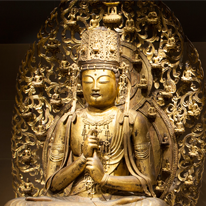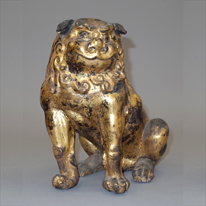Past Exhibitions
- Feature Exhibition: Masterworks of Kongō-ji Temple
- March 3, 2015 - March 29, 2015
If you have been to the new Heisei Chishinkan Wing, you know that its sculpture gallery is currently dominated by two imposing statues of Seated Mahāvairocana Buddha (Dainichi Nyorai) and Seated Ācalanātha (Fudō Myōō), both designated Important Cultural Properties. These enormous sculptures come from the temple of Kongō-ji in Amano-cho, part of the city of Kawachinagano, Osaka prefecture. They are on view at the museum after having undergone conservation at the museum's Conservation Center for Cultural Properties. This Special Feature introduces even more of the many treasures that have been preserved in Kongō-ji, one of the most important repositories for cultural properties in the Kawachi region of southern Osaka.
The formal name of this temple is Amanosan Kongō-ji. Part of the Shingon sect of Esoteric Buddhism, it is said to have been founded by the priest Gyōki (668–749). In the late Heian period, it was revived by the priest Akan (1136–1207) and became one of an elite group of "Hachijō-in" temples under the sponsorship of Imperial Princess Hachijō-in Akiko (1137–1211), the third daughter of Emperor Gotoba. Later, in the Nanbokuchō period (1333–1392), when the imperial court divided into Northern and Southern Courts, these Hachijō-in temples became part of the Daikaku-ji line of temples, which were associated with the Southern Court. During the 1300s, Emperor Gomurakami even resided temporarily at Kongō-ji for a time. Such events are extremely important when considering the history and artworks of this temple.
Among the artworks owned by Kongō-ji are four National Treasure handscrolls of the Engishiki (lit., "Procedures of the Engi Era"; volumes 9, 12, 14, and 16) as well as a National Treasure double-edged sword. In addition, it has preserved manuscripts and documents, paintings, arms and armor, and other outstanding works. Many of the manuscripts have been studied recently by scholars of Japanese literature. This exhibition shares the results of such recent research as it introduces the art and history of this significant Osaka temple.













